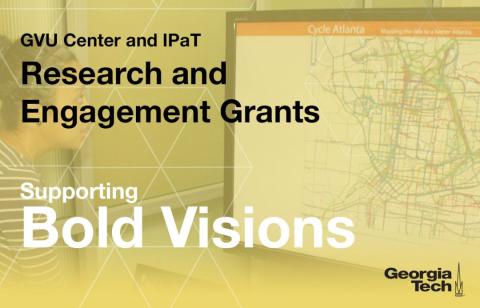event
GVU Center Brown Bag: Keith Edwards - Center Overview and Research Grant Projects
Primary tabs
In the first GVU Brown Bag Seminar of the academic year, Keith Edwards, GVU Center Director and Professor of Interactive Computing, will kick off our talk series with an overview of the GVU Center detailing its unique resources and opportunities, and previewing some of the events coming up this semester. Come, enjoy lunch, and learn about some of the ways you can connect with GVU. Following the brown bag talk, stick around for our fall ice cream social.
Also, each year, the GVU Center and IPaT announce funding for the Research and Engagement Grants, which support early stage work by Georgia Tech researchers. This year’s winners will give brief overviews of the work they will be doing over the coming academic year.
Research and Engagement Grant Projects:
Passive Haptic Rehabilitation for Stroke
Thad Starner (Interactive Computing); Steve Wolf (Emory Rehab Medicine)
We aim to develop a low-cost, mobile, wearable device for Stroke rehabilitation. Over 5 million people are disabled by stroke each year. Current techniques for stroke rehabilitation are costly and time-consuming, require cumbersome machinery, access to clinicians, and put strain on patients. However, using our lightweight and mobile computerized gloves, patients may be able to get rehab on-the-go. In our initial work, we found that tactile stimulation, like vibration, can improve sensation and mobility when applied to the impaired hands of people with partial Spinal Cord Injury. We now apply this "Passive Haptic Rehabilitation" to stroke. Using this technique, these patients can simply wear a vibrating glove to stimulate their affected hand while they go about their daily life. After two months, function improved in those that wore the glove.
(T)racing Eyes and Hearts: An Installation to Explore the Physiology of Empathy
Anne Pollock (Literature, Media and Communication); Lewis Wheaton (Applied Physiology); Nassim JafariNaimi (Literature, Media and Communication)
Eyes darting, or maintaining a steady gaze straight ahead. Heartbeat racing, or maintaining a slow, even rhythm. If we encounter these phenomena in another, how do we respond – not just affectively, but physiologically? Eye movements and heartbeats are among the most intuitively meaningful physiological characteristics that humans observe in one another. Without necessarily consciously realizing it, we often respond empathetically. This project brings together humanities scholars and physiology scholars to create an art installation that uses representation, tracking, and visualization to investigate and reflect upon the physiology of empathy. The installation renders video of eye movements and audio of heartrate of a virtual person, and tracks the eye movements and heartrate of an observing user. We anticipate a mirroring, empathetic physiological response from the user, in which their heartrate also speeds and slows in conjunction with the virtual person. Immediately after the experience, the user will be provided a visual and auditory representation of the data, in order to see and reflect on this empathetic engagement, and also provided with a link to a copy of the video by email if they so choose. The playback could be either in real time, or in a time that is set to either the virtual person or the user’s heartrate as a metronome, to allow a distinctively human-centered exploration of the data.
Collision of Creatives
Laura Levy (IMTC), Maribeth Gandy (IMTC), Clint Zeagler (WCC), Madison Cario (Arts@Tech), Lane Conville-Canney (Arts@Tech)
This engagement grant addresses the need to 1) understand how artists and technologists ideate, communicate and create within their groups and 2) create effective methods and design processes that provide collaborative access points for artists and technologists to effectively work together. The methods in this proposal seek to create a bridge between artists looking to integrate advanced technologies in their process with the designers making these technologies. Additionally, this project will find ways to showcase past, current and future technology projects developed at Georgia Tech through the vehicle of artistic expression (e.g., visual, dance, musical). This project aims to make effective Dr. Bolter’s quote that “the arts are the tip of the HCI sword” by enabling effective communication, creating useful artifacts, and engaging the Tech community to catalyze processes by technologists and artists in showcasing the work happening here at Georgia Tech.
Groups
Status
- Workflow Status:Published
- Created By:Alyson Key
- Created:08/18/2016
- Modified By:Fletcher Moore
- Modified:04/13/2017
Categories
Keywords
Target Audience

